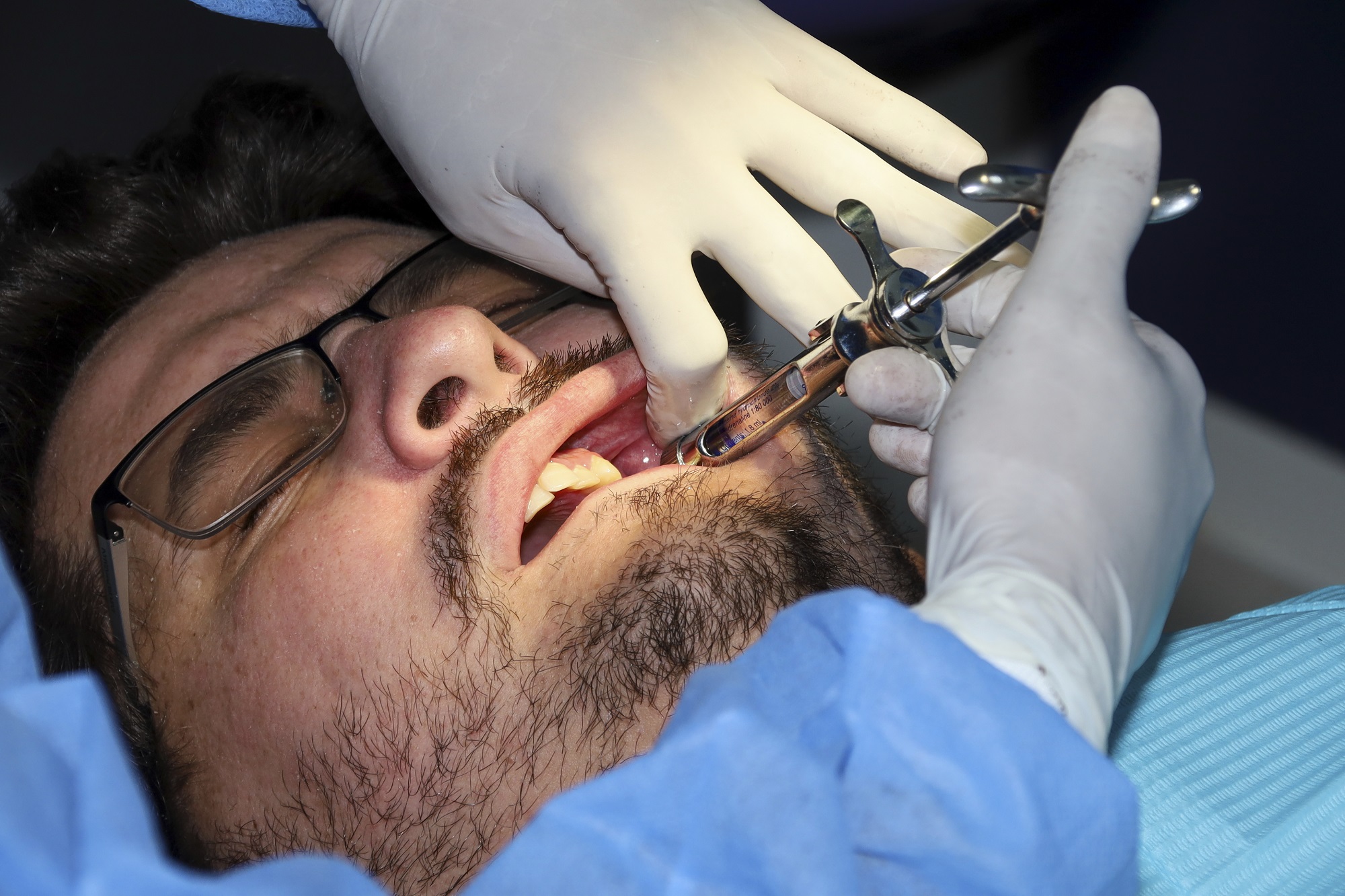
At Tooth Buddies, our Oral and Maxillofacial Surgery unit offers advanced surgical care addressing both functional and aesthetic concerns related to the face, jaws, teeth, and associated structures. From everyday extractions to complex jaw corrections and facial trauma, our surgeons bring a blend of precision, compassion, and innovation to each procedure. We handle a wide range of needs for both children and adults using state-of-the-art equipment, digital diagnostics, and strict safety protocols. Our interdisciplinary approach ensures coordinated care for faster healing and long-lasting results.
Wisdom teeth (third molars) often emerge misaligned or impacted, causing pain, infection, and crowding. We specialize in painless surgical extractions using digital imaging for precise planning. Whether it’s a simple removal or a deeply impacted case near nerves or sinuses, our team ensures minimal trauma, faster recovery, and reduced post-operative complications.
Dental and facial trauma can result from falls, sports injuries, accidents, or violence. Our clinic is equipped to handle emergencies such as fractured jaws, avulsed (knocked-out) teeth, and soft tissue lacerations. We offer immediate stabilization and long-term rehabilitation including cosmetic reconstruction, ensuring both function and aesthetics are restored.
Jaw misalignments can affect chewing, speech, facial appearance, and airway function. Our jaw surgery procedures correct underbites, overbites, open bites, and asymmetries. By repositioning the jawbones, we restore harmony between the teeth and facial skeleton. These surgeries are often done in coordination with orthodontic treatment and are crucial for managing TMJ disorders, sleep apnea, and congenital anomalies.
Facial harmony can be affected by uneven jaws or prominent chins. Cosmetic jaw surgery—also known as orthognathic cosmetic surgery—reshapes jawbones to enhance appearance and improve bite. These procedures help correct conditions like gummy smiles, long faces, weak chins, and facial asymmetry. Often paired with orthodontics or facial cosmetic treatments, these surgeries boost confidence and facial balance.
Permanent canines play a crucial role in bite alignment and facial contour. When they remain impacted (trapped in the bone or gum), surgical exposure allows them to be guided into position with orthodontics. Early intervention in adolescence can prevent crowding and maintain dental arch integrity. The procedure is minor and done under local anesthesia or sedation.
Jaw cysts and benign tumors (like odontogenic keratocysts or ameloblastomas) can weaken bones, displace teeth, and cause pain. We use advanced imaging and biopsy diagnostics to plan precise surgical removal while preserving as much bone and healthy tissue as possible. Our team ensures complete excision, close monitoring for recurrence, and guidance on future oral rehabilitation.
For patients suffering from Obstructive Sleep Apnea (OSA) or chronic snoring, our surgical interventions target anatomical causes of airway blockage. Procedures may include uvulopalatopharyngoplasty (UPPP), genioglossus advancement, or maxillomandibular advancement. These surgeries improve airflow, reduce health risks associated with apnea, and significantly enhance quality of life and sleep quality.
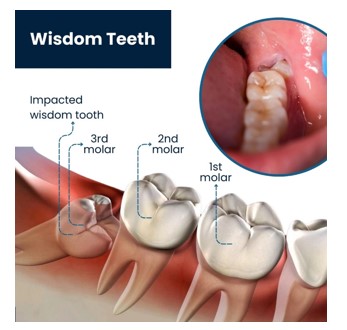
Wisdom teeth, or third molars, are the last permanent teeth to appear (erupt) in the mouth. These teeth usually appear between the ages of 17 and 25. Some people never develop wisdom teeth. For others, wisdom teeth erupt normally — just as their other molars did — and cause no problems.
Many people develop impacted wisdom teeth — teeth that don't have enough room to erupt into the mouth or develop normally. Impacted wisdom teeth may erupt only partially or not at all.
An impacted wisdom tooth may be:
Mesioangular: Grow at an angle toward the next tooth (second molar)
Distoangular: Grow at an angle toward the back of the mouth
Horizontal: Grow at a right angle to the other teeth, as if the wisdom tooth is "lying down" within the jawbone
Vertical: Grow straight up or down like other teeth but stay trapped within the jawbone
What Problems can occur with impacted wisdom teeth?
Will wisdom teeth cause future dental problems?
It's difficult to predict future problems with impacted wisdom teeth. However, If there isn't enough space for the tooth to erupt, it's often hard to get to it and clean it properly. Resulting food lodgement can give rise to tooth decay, gum problems and inflammation of the overlying gum.Older adults may experience difficulty with surgery and complications after surgery.
What you can expect
During the procedure
Your dentist or oral surgeon may use one of three types of anesthesia, depending on the expected complexity of the wisdom tooth extraction and your comfort level. Options include:
During wisdom tooth extraction, your dentist or oral surgeon:
After the procedure
If you receive sedation anesthesia or general anesthesia, you're taken to a recovery room after the procedure. If you have local anesthesia, your brief recovery time is likely in the dental chair.
As you heal from your surgery, follow your dentist's instructions on:
Risks
Most wisdom tooth extractions don't result in long-term complications. However, removal of impacted wisdom teeth occasionally requires a surgical approach that involves making an incision in the gum tissue and removing bone. Rarely, complications can include:
In addition to making the area numb with local anaesthetic, your surgeon may suggest sedation to allow you to be more comfortable during the procedure. A wisdom tooth extraction is almost always performed as an outpatient procedure. This means that you go home the same day.
You'll receive instructions from the hospital or dental clinic staff on what to do before the surgery and the day of your scheduled surgery.
When to call your dentist or surgeon
Call your dentist or oral surgeon if you experience any of the following signs or symptoms, which could indicate an infection, nerve damage or other serious complication:
Follow up appointments:
You probably won't need a follow-up appointment after a wisdom tooth extraction if:
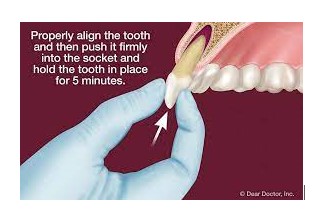
What are the common causes of dental and facial trauma?
Dental and facial trauma can result from various incidents, including sports injuries, falls, car accidents, and physical altercations.
What are the immediate steps to take after a dental or facial injury?
If a tooth is knocked out, handle it by the crown, rinse it gently, and attempt to reinsert it into the socket or store it in milk. Control any bleeding with direct pressure and seek immediate dental or medical attention.
What are the treatment options for a fractured jaw?
Treatment for a fractured jaw may involve surgery to stabilize the fracture, wiring the jaw shut to allow healing, or a combination of both.
When should I seek emergency care for dental or facial trauma?
Seek emergency care for severe bleeding, difficulty breathing, loss of consciousness, or signs of a broken jaw or facial bones.
What is the role of an oral and maxillofacial surgeon in treating facial trauma?
Oral and maxillofacial surgeons are trained to diagnose and treat facial injuries, including fractures, soft tissue lacerations, and dental injuries. They can perform reconstructive surgery and manage complications related to facial trauma.
What is corrective jaw surgery?
Orthognathic surgery, or simply jaw surgery, is surgery designed to correct conditions of the jaw and lower face related to structure, growth, airway issues including sleep apnea, TMJ disorders, alignment problems primarily arising from skeletal disharmonies, dental bite problems that cannot be easily treated with braces alone.
Difficulty in the following areas should be evaluated for the possible need for corrective jaw surgery:
Who performs these surgeries?
Jaw surgery is performed by maxillofacial or an oral surgeon or a plastic surgeon in collaboration with an orthodontist. It often includes braces before and after surgery, and retainers after the final removal of braces. Orthognathic surgery is often needed after reconstruction of cleft palate or other major craniofacial anomalies. Careful coordination between the surgeon and orthodontist is essential to ensure that the teeth will fit correctly after the surgery.
How is this surgery planned?
Planning for the surgery usually involves input from a multidisciplinary team, including oral and maxillofacial surgeons, orthodontists, and occasionally a speech and language therapist. Although it depends on the reason for surgery, working with a speech and language therapist in advance can help minimize potential relapse. The surgery usually results in a noticeable change in the patient's face; a psychological assessment is occasionally required to assess patient's need for surgery and its predicted effect on the patient. CT scans, xrays and photographs are taken to help in the planning. A virtual surgery software helps to predict the shape of the patients face post-surgery. Great care needs to be taken during the planning phase to maximize airway patency.
Why are braces required for this surgery?
Orthodontics are a critical component of orthognathic surgery. Traditionally the presurgical orthodontic phase can take as long as one year and undertaken with conventional metal braces. However, these days new approaches and paradigms exist including surgery-first and using clear aligner orthodontia (like Invisalign).
What is upper jaw surgery/ Le Fort 1 osteotomy?
The LeFort I osteotomy is commonly used for the correction of severe overbites,underbites and jaw deformities as it allows movement in all 3 planes. Furthermore, it is commonly used to treat midface hypoplasia and gummy smiles. An underbite associated with maxillary hypoplasia is commonly found in patients with orofacial clefts, obstructive sleep apnea (OSA), and maxillary atrophy. Combined with lower jaw surgery, it improves the esthetics for patients with facial asymmetry .
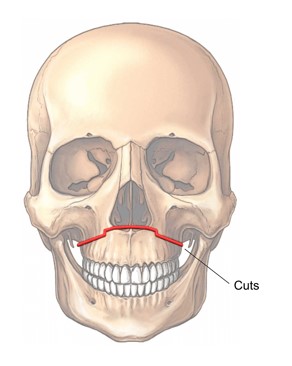
What is lower jaw surgery?
The bilateral sagittal split osteotomy(BSSO) is probably one of the most versatile surgical procedures performed for advancing or retruding the lower jaw. A BSSO can be performed alone or in combination with an upper jaw or chin surgery. Braces continue for several months before and after the surgery.
The operation is almost entirely carried out from the inside of the mouth to minimise visible scars on the skin of the face. A cut is made through the gum behind the back teeth to gain access to the jawbone. The lower jaw is then cut with a small saw to allow it to be broken in a controlled manner. It is then moved into its new position and held in place with small metal plates and screws.
Occasionally it is necessary to make a small “stab” incision on the skin of the face to allow the screws to be inserted. This incision is a few millimetres long and usually only requires a single stitch to hold it back together. The gum inside the mouth is stitched back into place with dissolvable stitches that can take a fortnight or even longer to fall out.
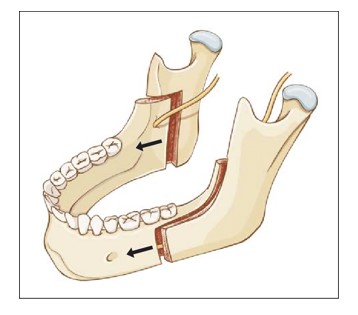
What is chin surgery?
Genioplasty or Chin surgery, is a surgical procedure to reshape the chin either by enhancement with an implant or reduction surgery on the bone. Oral-maxillofacial surgeons with specific training and experience in treating the head, face, mouth, and jaw typically perform genioplasty procedures.
However, plastic surgeons can also perform this type of surgery if they have the necessary training and experience. People typically receive general anesthesia before a genioplasty procedure.
The exact operation and recovery times vary, depending on the type of genioplasty a person is undergoing and the extent of corrections a surgeon is performing.
Surgeons use chin repositioning surgery to correct the following problems:
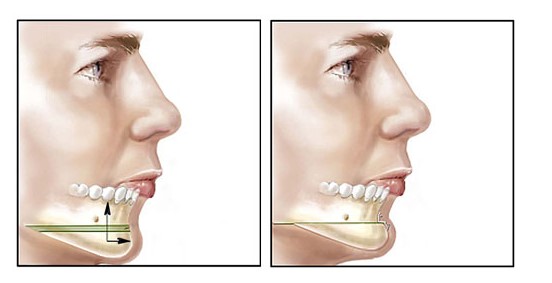
Virtual 3D Surgical Planning
The virtual surgical planning has been used for numerous types of jaw surgery procedures. First, obtaining an accurate and detailed representation of facial asymmetries is a valuable diagnostic tool. Second, the technique allows for adjustments in simulating different operative techniques, which translates into customized treatment plans and better outcomes.

PRE SURGERY
POST SURGERY SIMULATION

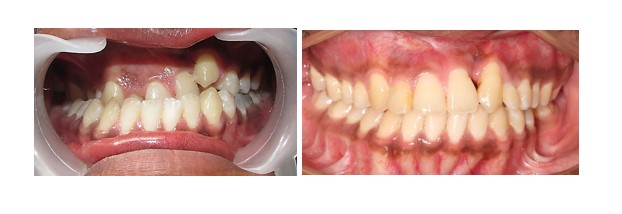
What is an impacted canine tooth?
An impacted canine tooth is a tooth that doesn't erupt into its proper position in the dental arch. It's often blocked from emerging by other teeth or bone, and may be stuck in the jawbone or gums.
What causes canine teeth to become impacted?
Impacted canines can result from several factors, including insufficient space in the jaw, genetics, developmental anomalies, or the presence of extra teeth or retained baby teeth.
What are the signs of an impacted canine?
Signs can include a gap where the canine should be, a throbbing toothache, gums that are red or inflamed, or the tooth partially emerging at an unusual angle.
What are the treatment options for impacted canines?
Treatment often involves a combination of orthodontics (braces) to create space and oral surgery to expose the impacted tooth and potentially guide it into place with a bracket and chain.
How long does treatment take?
Moving an impacted canine can be a slow process, sometimes taking over two years. Regular orthodontic adjustments are necessary, and the impacted tooth may be sore for a few days after each adjustment.
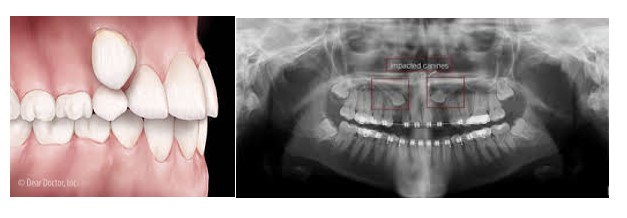
What are the symptoms of a benign jaw cyst or tumor?
Symptoms can include jaw pain or tenderness, swelling (which may or may not be painful), changes in facial appearance, a noticeable lump on the jawbone, difficulty or changes in your bite, and loose teeth. Some cysts and tumors may be asymptomatic and found during routine dental X-rays.
What causes benign jaw cysts and tumors?
The exact causes are often unknown, but some are associated with genetic changes or syndromes. Odontogenic cysts and tumors originate from tissues involved in tooth development, while non-odontogenic tumors can develop from other jaw tissues like bone or soft tissue.
What is the treatment for a benign jaw cyst or tumor?
Treatment usually involves surgical removal of the cyst or tumor. Depending on the size and location, this may be done under local or general anesthesia. In some cases, a bone graft or other reconstructive surgery may be needed.
What is the recovery process like after surgery?
Recovery time varies depending on the extent of the surgery, but patients can usually return to light activities within a few days to a couple of weeks. Full jaw healing can take around six weeks. Pain and swelling are common post-surgery and can be managed with prescribed medications.
What are the potential complications of benign jaw cysts and tumors?
While benign, these growths can cause problems like facial asymmetry, pain, tooth displacement, malocclusion, and recurrence if not completely removed. In rare cases, distant metastases can occur with some tumors.

Tooth Buddies delivers quality dentistry with a personalized touch. Each patient is treated with the utmost care, compassion, empathy.
Copyright © 2025 All Rights Reserved.